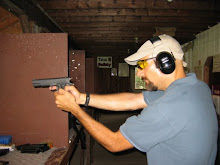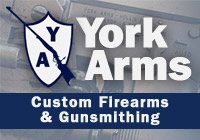Had an interesting e-mail exchange (and subsequent phone call) from Dennis of Dragon Leatherworks, he of the Fugly fame. Dennis had sent me some sooper-seekrit pictures of a new holster he's been working on (it is gorgeous...) and I mentioned that it would look great with a 1911 sitting in it - like my Gold Cup... Well, come to find out, Dennis may be a leatherworker extraordinaire, biker, and all-around Renaissance man, but he's a newcomer to the 1911 world. He asked a few basic questions about the different sizes, and I realized that we had the makings of a pretty good primer going.
Consider this, then, the "1911s for Dummies", if you will. For this primer, we'll consider the various sizes of 1911s only - it's confusing enough without getting into the myriad chamberings (both recent and historical) or the inner workings (although I do foresee a "how it works" type post in the future where we take one apart and examine the pieces parts). Right off the bat, pretty much everything you'd ever want to know about the 1911 and then some can be found at various places around the web, with one of the more prominent sites being M1911.org.
To get started, there are three basic sizes:
- Government - 99 times out of 100, when someone says "1911", they are referring to a Government model - this is the standard military issue 1911 with a 5" barrel and a full-sized grip. Magazine capacity was historically 7 rounds, but recent advances in metallurgy have allowed 8 round magazines to become commonplace.
- Commander - same grip (frame) as the Government model, but with a 4¼" barrel (slide) rather than the 5".
- Officer's - reduced grip - magazine capacity is reduced by one, with historical capacity being 6 but now increased to 7 - and a 3½ barrel.
Some manufacturers - such as ParaOrdnance or STI - offer double-stack 1911s with capacity of up to 14 rounds in the full-size configuration and 10 rounds in the compact. However, these are affronts to the memory of John Moses Browning (Peace Be Upon Him), so we will spake no further of such wrongness. I kid, I kid, but for a reason - once the traditional 1911 design is breached, the sizing is pretty much dependent on the individual firearm. Oh, and we won't even start to get into the LDA abomination... The 1911 was designed to be a single action, single stack firearm chambered in the very capable .45 ACP. End sermon.
There are dozens, if not hundreds, of small, medium, or large gun companies putting out 1911 models. From the Norinco knock-offs to the Argentinian Ballester Molina to the Spanish Llama, even foreign companies have made 1911s. Here in the US, it seems like everyone from AutoOrdnance to Wilson Combat makes some form of the classic. There are ultra-high end Les Baers and STIs and Wilson Combats all the way to the entry level Rock Island Armory (yes, they're Philipino but they sorta count, right?) and the aforementioned AutoOrdnance (owned by Kahr Arms right here in Worcester, MA).
The real beauty of the 1911 in all of its various sizes is that they all fit the same gear. A holster built to carry a Government model will fit a Commander or an Officer's exactly the same - and even in reverse if the holster is not closed over the muzzle. Magazines for the full sized guns can be used in the Officer's sized guns (but not the reverse, and unfortunately they are close enough so that if you accidentally load an Officer's magazine in your full-size 1911, it will juuuuust barely stay in long enough for you to watch the mag drop on the ground when you release the slide. Don't ask me how I know...) Grips and magazines are fully interchangeable between the Government and Commander models as well as between the Defender and the Officer's.
Subsequent 1911 tutorials will cover different chamberings, how the 1911 functions, and perhaps even an illustration or animation or two. Perhaps I'll even drag out my various and sundry 1911s (and 1991s) for a "group photo" for a Friday gun pr0n - as far as I'm concerned, you can never have enough 1911 goodness. Heck, a discussion of the Mustang/.380 Government could be a possibility as well - I just wish I had one to showcase... I also might be interesting in expanding to other handguns - like the different frame sizes of Smith & Wesson, although I hardly have the range of someone like Tam.
Hope this was informational for the new handgunners out there!
That is all.







4 comments:
The commander has the same grip size as the government model, but not the same grip frame. I believe the dust cover is shorter by a fraction of an inch because of the reduced barrel length.
Also a lot of "commander" models aren't. A lot of manufacturers are turning out 4" models with full length guide rods instead of 4.25" with plugs.
One word of caution. When using standard length mags in an Officer's model it is possible to get the magazine in past the mag release and up into the ejector, jamming the gun.
Wilson Combat makes a full length mag with a stop to work in an officer's model and X-Grip makes an adapter that I haven't tried but is said to allow one to use standard mags as well.
Jeff,
Good points, definitely. I guess "Commanderish" would be the term, eh?
DesertRat,
I've used standard Wilson Combat 8 rounders, Chip McCormack Shooting Star 8 rounders, and US GI 7 rounders in my 1991A1 Compact with no issues.
The only issue I had was inserting the Officer's mag into the Gold Cup, whereupon it dropped out onto the shooting bench when I hit the slide release... D'OH!!!
I think CCO stands for "Colt Commander Officer", as it has the frame of one and the slide of the other.
Dan Wesson uses the term "Concealed Carry Officers."
Para's CCO is "Concealed Carry Option" but it is a reverse Colt CCO.
Post a Comment